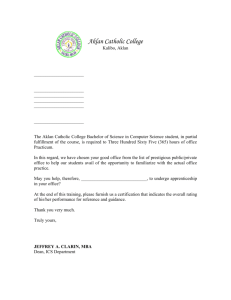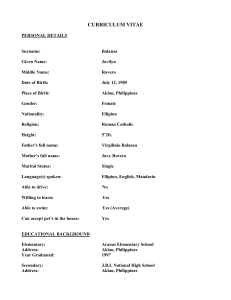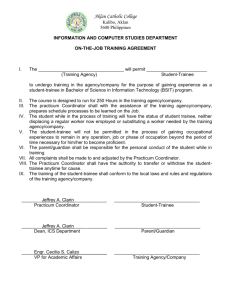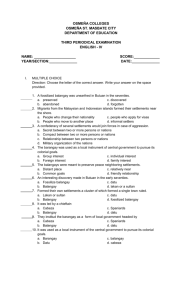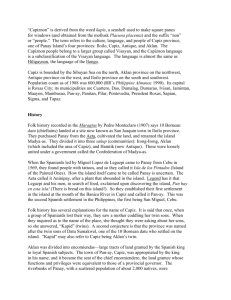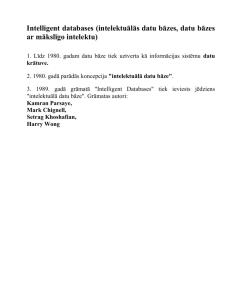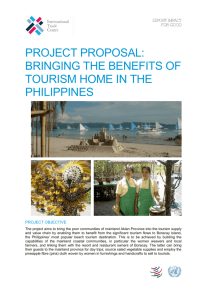“Aklanon” refers to the people of Aklan province, their language, and
advertisement
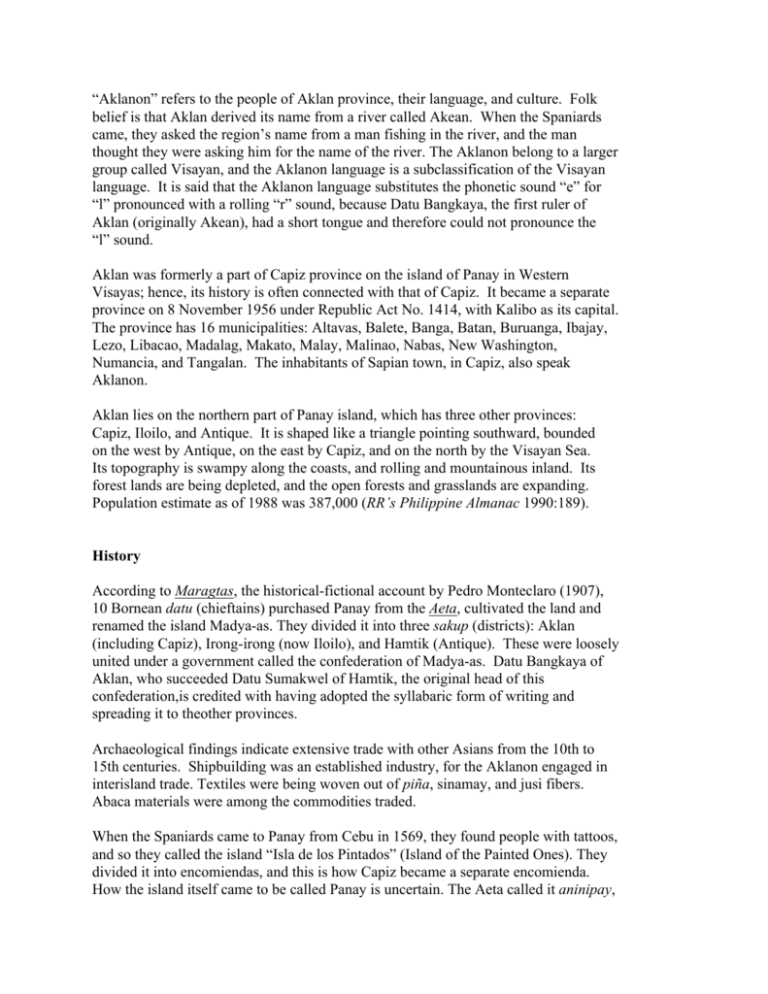
“Aklanon” refers to the people of Aklan province, their language, and culture. Folk belief is that Aklan derived its name from a river called Akean. When the Spaniards came, they asked the region’s name from a man fishing in the river, and the man thought they were asking him for the name of the river. The Aklanon belong to a larger group called Visayan, and the Aklanon language is a subclassification of the Visayan language. It is said that the Aklanon language substitutes the phonetic sound “e” for “l” pronounced with a rolling “r” sound, because Datu Bangkaya, the first ruler of Aklan (originally Akean), had a short tongue and therefore could not pronounce the “l” sound. Aklan was formerly a part of Capiz province on the island of Panay in Western Visayas; hence, its history is often connected with that of Capiz. It became a separate province on 8 November 1956 under Republic Act No. 1414, with Kalibo as its capital. The province has 16 municipalities: Altavas, Balete, Banga, Batan, Buruanga, Ibajay, Lezo, Libacao, Madalag, Makato, Malay, Malinao, Nabas, New Washington, Numancia, and Tangalan. The inhabitants of Sapian town, in Capiz, also speak Aklanon. Aklan lies on the northern part of Panay island, which has three other provinces: Capiz, Iloilo, and Antique. It is shaped like a triangle pointing southward, bounded on the west by Antique, on the east by Capiz, and on the north by the Visayan Sea. Its topography is swampy along the coasts, and rolling and mountainous inland. Its forest lands are being depleted, and the open forests and grasslands are expanding. Population estimate as of 1988 was 387,000 (RR’s Philippine Almanac 1990:189). History According to Maragtas, the historical-fictional account by Pedro Monteclaro (1907), 10 Bornean datu (chieftains) purchased Panay from the Aeta, cultivated the land and renamed the island Madya-as. They divided it into three sakup (districts): Aklan (including Capiz), Irong-irong (now Iloilo), and Hamtik (Antique). These were loosely united under a government called the confederation of Madya-as. Datu Bangkaya of Aklan, who succeeded Datu Sumakwel of Hamtik, the original head of this confederation,is credited with having adopted the syllabaric form of writing and spreading it to theother provinces. Archaeological findings indicate extensive trade with other Asians from the 10th to 15th centuries. Shipbuilding was an established industry, for the Aklanon engaged in interisland trade. Textiles were being woven out of piña, sinamay, and jusi fibers. Abaca materials were among the commodities traded. When the Spaniards came to Panay from Cebu in 1569, they found people with tattoos, and so they called the island “Isla de los Pintados” (Island of the Painted Ones). They divided it into encomiendas, and this is how Capiz became a separate encomienda. How the island itself came to be called Panay is uncertain. The Aeta called it aninipay, after a plant which was abundant in the island. Or it might have been named after the first Spanish settlement, called Pan-ay. Legend has it that Legazpi and his men, in search of food, exclaimed upon discovering the island, “Pan hay en esta isla!” (There is bread on this island!). Kalibo, whose name derives from the native name for pineapple, became a parish in 1620, and a church of mixed materials was built on the site now called Laguingbanwa. Aklan’s northern coasts made it vulnerable to Muslim invasions. In 1813 and 1835, for instance, Muslim vinta carrying about 1,000 pirates attacked the seashore town of Buswang, Kalibo, and took with them slaves and loot. Of particular pride among the Aklanon is their involvement in the Katipunan (a revolutionary organization) and the Philippine Revolution against Spain. Two Aklanon, Francisco del Castillo and Candido Iban, who were in the pearl-fishing business, won in a lottery. They donated 1,000 pesos to the revolutionary movement for the purchase of a printing press. As Katipunan members, they were instructed by Andres Bonifacio to return to Aklan and organize. Members were secretly enlisted in the barrios of Ochando, Kawayan, and Tambak in Lagatic (now New Washington) and in Batan; membership quickly spread to the rest of the province. Del Castillo, the provincial head, died in battle on 17 March 1897. Two days later, the Spanish commanding general enticed the katipunero (Katipunan members) to surrender with the promise of amnesty. On 22 March many responded. In Kalibo, 50 Katipunero surrendered and were immediately thrown in jail. Twenty of them were chosen for execution. One of them, however, was released through his wife’s intercession. At about midnight of 23 March, the 19 Katipunero were shot and their bodies paraded that morning around the plaza. They are now honored as the “19 Martyrs of Aklan.” The revolutionary fervor of the Aklanon intensified, and the Spaniards finally evacuated Kalibo in late December 1898. Shortly after the defeat of the Spaniards, however, American troops arrived and bombarded Iloilo on 11 February 1899. In March 1901, General Ananias Diokno, who had been sent by General Emilio Aguinaldo to organize the resistance against the Spaniards and who subsequently became one of the leaders of the war against the Americans, surrendered in Kalibo. Civil government was established in Capiz/Aklan on 14 April 1901. Twelve years later, Victorino Mapa of Kalibo became a member of the Philippine Commission. He also became the first Panayanon chief justice of the Supreme Court of the Philippines. In 1934, six delegates of the Constitutional Convention came from Capiz/Aklan. Whenthe Commonwealth period was established, provincial and municipal leaders agitatedfor local autonomy. Gabriel K. Hernandez was elected governor of Capiz/Aklan, and the title of presidente municipal was replaced by municipal mayor. World War II came to Panay on 12 April 1942, with Japanese troops landing simultaneously in Capiz/Aklan, Iloilo, and Antique. This led to the formation of the Panay resistance movement, comprising the civil resistance movement and the Panay guerilla force. The war ended in 1945, and the country became politically independent the following year. During the 1950s, Representative Godofredo P. Ramos authored a bill separatin Aklan from Capiz. The bill was approved by President Ramon Magsaysay, and the first appointive governor was Rose Raz Neñez. In 1959, Ramos became the first elected governor of Aklan. Other leaders who have achieved national prominence are Commissioner of Civil Service Abelardo Subido, Postmaster-General Enrico Palomar, and Executive Secretary Alejandro Melchor Jr. Economy Agriculture is the main occupation, with rice and corn produced in abundance. The topography favors the development of the fishpond industry and coconut plantations. Fishing is a major industry, and there is a National College of Fisheries in New Washington. Copra is an export commodity. Fruits such as banana, melon, and pineapple are produced and the surplus shipped to Manila. Abaca, also abundant, is used to make slippers, mats, and bags. Other cottage industries are weaving, rattan furniture, woodcraft, and hat making. Kalibo is known for the production of pineapple fiber which is woven into the cloth called piña, a fabric used for the barong tagalog (long-sleeved shirt with collar, worn untucked), gowns, table cloths, and curtains. Aklan is also rich in mineral resources such as chromite, manganese, and gold, but the mines have not been developed. Political System Late 16th-century accounts such as Miguel de Loarca’s and an anonymous manuscript now referred to as the Boxer Codex say that traditional Panayanon government was headed by the datu, who, as head of a sakup, was the judge in matters of dispute, the protector and defender, and a feudal lord. His subjects were called sinakpan, whose property he appropriated when they died. Any of the datu’s sons could claim succession; hence, warfare could erupt among brothers competing for the throne. Or the disgruntled brother of a newly installed datu could start his own sakup. A class of warriors called timawa owed fealty to the datu. Their main function was to protect the datu, including tasting his wine for poison. They accompanied him on raids and were on familiar terms with him. They themselves were descendants of datu, the first-generation timawa having been the illegitimate sons of the datu and slave women. The rest of the sinakpan were the oripun, who economically and politically supported the datu and timawa, as the latter two did not engage in agricultural or industrial activity. Legislative decisions by the datu were done publicly and with the guidance of the ponuan, a council of elders knowledgeable in matters of custom law. Although law was handed down by tradition, amendments could be made with the consensus of the other datus. The datu decided on a case after listening to the sworn testimony of the conflicting parties. All crimes, including murder and disobedience to the datu, were punishable by fines, which could be paid for with servitude. Oral history considers the Maragtas Code, also known as the Sumakwelan Code, as the earliest legal system. It covered aspects of human behavior and relationships, such as property rights, inheritance, contracts, and family relations. Village criers, called umalahokan, rang a bell to call the people to a gathering place where the datu’s message was announced. To this day, the system of calling the townspeople to assembly is practiced in the rural areas. The punishment for the violation of laws was varied: humiliation, forced labor, whipping, drowning, and burning. Aklan province was created under Republic Act 4979. It is classified as a fourth-class province according to income. A governor, vice-governor, and a provincial board administer the province. Aklan has one seat in Congress. (RR’s Philippine Almanac 1990:136-137) Social Organization and Customs The traditional social hierarchy consisted of five classes: datu, timawa, oripun, Negrito, and outsiders from across the seas. An origin myth claims these were the classes that made up all of humankind. The term “datu” referred to both the social class and the headman who belonged to this class. He had a retinue of personal vassals called timawa. The two upper classes were economically supported by the commoner class, called oripun, which was further divided into 12 subclasses ranging from the bihag (captive slaves) to the tumataban (“the most respected” commoner serving only five days of labor per month). Vertical mobility was possible within this social structure. Slaves, for instance, could become free after paying off their debts, which might have been the cause of their slavery; or they could be freed by a grateful master. Slaves could also go up the ladder of the 12 subclasses within their class. However, the datu kept the noble line unbroken by marrying only princesses of other sakup, whether by proper arrangement or by abduction. The princesses were binokot “caged” or “wrapped up,” meaning reserved for the appropriate marriage. The illegitimate sons of a captive binokot princess and the datu became the timawa. Upon their father’s death, they were set free and called ginoo. By the 17th century, the noble classes, datu and timawa alike, had been absorbed into the Spanish colonial structure. The timawa, now subjugated by Spanish military might, had to make a living by farming or fabric weaving. The word’s current meaning is “poor” or “destitute.” The datu class was also called manggaranon (rich), halangdon (held in high respect), and dungganon (honorable). Among the other halangdon and dungganon were the sabiosar (wise) and the babaylan (shaman). The datu was also the feudal lord and agalon (master) of the timawa and the oripun. Because the present agricultural system remains feudal, these terms are still in current use. The traditional Aklanon kinship system followed the general Philippine pattern, relationship being traced along both paternal and maternal lines, with terms of address for each member of the family. Marriage arrangements were traditional: parental approval and arrangement were requisite to a ceremony called pamaeaye or pabaeayon. The marriage celebration itself was festive and costly. The newlyweds could stay with the bride’s family for a few days, then moved in with the groom’s family for a longer period until the couple set up residence, usually as decided on by the husband, with his wife’s concurrence. In the past, the groom was expected to serve the bride’s family for the first few months. Then and now, the father was the head of the family, although household matters—preparing the meals, buying clothing for the family, entertaining visitors and relatives, attending to the children’s needs—were the mother’s responsibilities. Grandparents were respected and cared for, their opinions sought and advice followed. Children inherited property equally. Religious Beliefs and Practices The early Panayanon believed in many gods. Bululakaw lived in the island’s sacred mountain called Madya-as. A chief goddess was believed to reside in the mountain of the nearby island of Negros Occidental. She was called Laon, after whom Mount Kanlaon is named. There were mediators to the gods, also said to be the first priests: Bangutbanwa, who prayed for good harvests and an orderly universe; Mangindalon, who interceded for sick persons and prayed for the punishment of enemies; and Soliran and Solian, who performed marriage ceremonies. Manunubo was the good spirit of the sea. Although the majority of the Aklanon population is now Christian, belief in the power of the babaylan has not completely disappeared in spite of their dwindling numbers. In pre-Christian times, the babaylan played an important political, social, religious, and cultural role. They advised the datu, and were the spiritual and physical healers of the community. They officiated in ceremonies that marked the life cycle of each villager. The babaylan were most resistant to Spanish rule. They tried to maintain their influence over the Christianized villagers, sometimes succeeding in winning them back to the worship of their anito, and at times leading popular revolts. Reverence for patron saints has not completely replaced the belief that engkanto (supernatural beings) reside in places called mari-it, such as cliffs, bamboo groves, boulders, and earth mounds. The palhi are either evil spirits or their dwelling place. Aswang (flesh-eating ghouls) come in different forms. The tiktik is a bird that eats human liver; the bagat, usually in the form of a huge dog or some grotesque creature, preys on lone travelers; the sigbin, also a dog, preys on people at noontime; the bawa looks like a big hen, but it can easily snap its victim’s neck. The kama-kama are lazy and funloving dwarfs living in earth mounds. The tamawo are either friendly or evil spirits, and live in resplendent palaces that look like mere boulders to the human eye. Through a peculiar act of courtship called yanggaw, they entice humans who attract them. Hiwit or barang is a ritual that gives one the power to inflict pain on an enemy. In pre-Spanish times, a significant religious ceremony was held every seven years to pray for the “strengthening of the universe.” The people of Irong-irong, Hamtik, and Aklan convened near a spring whose waters flowed back to the mountains, and made sacrifices and offerings for seven days. The folk belief is that sickness is caused either by spirits of ancestors feeling neglected, or by environmental spirits dwelling in the palhi, especially the noknok (banyan) tree. The environmental spirits are offended when one trespasses on their property without asking for permission. The aggrieved spirits must then be appeased with the toos and kiyaw-kiyaw ritual. In the toos ritual, incense is placed in a coconut shell, its smoke wafted around the sick person. A ball of rice is wrapped in black cloth, and then hung over the patient. In the morning, native cakes— pinais, binodbod, and hilaw-hilaw— are prepared. These are made of maeagkit (glutinous rice), young coconut, and sugar. Each type of rice cake is divided into seven pairs and wrapped in banana leaves. At 3 or 4 P.M., a roosterand a pullet are butchered and dressed without the use of a knife. The entrails of bothfowl are taken out, cleaned and returned, along with their blood, back into their bowels. The feathers are wrapped in paper and hung above the doorway. The chicken are boiled without salt. At 6 P.M., a winnowing tray is laid on the floor of the living room; placed here are the seven pairs of each rice cake and the fowl, plus a plate of cooked rice and seven slices of boiled egg. On the floor beside the winnower are a pot of tuba (coconut wine), a glass of water, a bundle of clothes, a saucer holding seven pairs of tilad (betel chew), and slim cigars. The pot of tuba is covered with a payaw leaf through which two small bamboo tubes are inserted and used as drinking straws. A coconut shell with embers is prepared for incense smoking later. Desinario, the praying of the rosary for this particular occasion, then commences. The herbolario/babaylan joins the rosary while performing the sagda. Holding the coconut shell from which incense smoke emanates and muttering prayers, the babaylan circles around the offerings seven times and then reverses direction another seven times. He/she invites the spirits to come, takes the glass of water, and washes the hands of the invisible beings who are believed to be sitting around the food. The spirits having eaten, bits of each offering are taken by the babaylan and tossed out the door for all the other spirits outside the house. He/she then offers the clothes and the tilad to the spirits and distributes the cigars around the floor. This ends the ceremony and guests partake of the pataw, the feast prepared by the host family. Another healing ritual is the panghatud, an offering brought to the palhi tree. It consists of lechon (roasted pig), a red rooster that has been cooked without salt, and fist-sized, unsweetened rice cakes, miniature replicas of a bow and arrow and a spear, 1 meter of kundiman (red cloth), and coins. Before the babaylan and the relatives of the sick person leave the house for the palhi tree, the babaylan takes a piece of ginger and marks a cross on the forehead of each household member. Everyone is strictly enjoined to stay inside the house, and the ladder removed to ensure that no evil spirit enters the house. The offering is laid on a table placed by the tree, and the babaylan addresses his/her prayer to the spirit in the tree. After some time during which the spirit is believed to have finished the meal, everyone is invited to eat. This is done in all solemnity, for it is not an occasion for revelry. Today most Aklanon have been Christianized, but the animistic practices continue, sometimes integrating Catholic rituals, like the January celebrations for the Santo Niño. Architecture and Community Planning The traditional house of the Aklanon is basically identical to the Visayan house, although it has distinctive features. The Visayan house is square, with one or two rooms. The roof, pyramid- or hip-shaped, is made of either cogon or nipa leaves. In Aklan, a house with several rooms may have a corresponding number of small roofs that “cluster tightly together to form a single mountainous mass” (Folk Architecture 1989). The main posts are made of agoho timber; the smaller posts, roof beams, and rafters, of dried bamboo. Rope and vine are used to tie beams and rafters. Instead of nails, which may split the bamboo, wooden pegs, and mortise-and-tenon are used. The walls are of woven bamboo slats, amakan or woven bamboo splints or flattened bamboo nodes. The floor, about 1.5 meters above the ground, is of bamboo slats that may be laid in such a way that the nodes form a design. Interior partitions, such as those between the living room and kitchen, are made of woven amakan. There must be at least one window facing the east, for good luck. Also for good luck, the owner determines the number of steps by reciting the words oro, plata, mata (gold, silver, death); and the builder must make sure that the steps do not end on the word “death.” The Aklan house is generally more austere looking than the houses of Iloilo and Capiz. The nipa roof is neatly trimmed, making it look very compact. Each of the four walls may consist entirely of split bamboo uniformly lined to form a continuous expanse. A decorative undertone may be achieved with a gable consisting of similarly lined bamboo, cut at the bottom to form scallops. If made of nipa, the shingles are neatly flattened with narrow bands of bamboo running horizontally across. A departure from the basic post-and-lintel structure of the doorway may be the archway over which lie horizontal bands to break the monotony of the walls’ vertical bamboo lines. Decorative accents are further created by the windows, which have relatively “fanciful latticework,” even if these consist merely of “sober rows of X’s” (Folk Architecture 1989). In the rural areas, the bamboo or nipa house stands squarely in the middle of the field, overlooking the various stages of the agricultural cycle. City or town planning, on the either hand, reveals traces of Spanish influence. The town center is a huge, open square called the plaza, from which streets and houses radiate. The plaza is surrounded by the cathedral, government buildings, and stone houses of the traditionally affluent. The residential stone houses of the Spanish period, some of which still stand today, derive their basic structure from the traditional rural house. The steep roof is hip shaped, originally of nipa but now replaced by galvanized iron; its living quarters are elevated. The stone wall has a wooden frame that still makes use of the post-and-lintel structure, identical to that of the nipa house. The stone ground floor is used as an office, storage space, a stable, or a garage. On the upper floor are a vestibule, living room, bedrooms, dining room, kitchen, toilet, and bathroom. Visual Arts and Crafts The traditional weaving method of piña is called pili or sinuksuk. This is a floating weft technique accomplished after the cloth weaving, an intricate process for embellishing piña fabric before it is cut and sewn into a gown. A typical design is a cluster of five-petalled flowers surrounding a butterfly. This is repeated in a series along the borders of the cloth. The pili or sinuksuk tradition continues to live because of weavers like Magdalena Marte and her niece Sosima de la Cruz. Marte was conferred the Manlilikha ng Bayan Award in 1990. An Aklanon visual artist who became prominent was Telesforo Sucgang, painter and sculptor, and a contemporary of Jose Rizal, Felix Resurreccion Hidalgo, and Juan Luna. Born in Banga, Sucgang was sent to Manila to study at the Colegio de San Jose and Colegio de San Juan de Letran. He then studied art at the Academia de Dibujo y Pintura. In 1879, in the contest sponsored by the Liceo Artistico-Literario, Sucgang won in the sculpture category an award for his entry of Cardinal Cisneros’ bust, while Rizal won in the poetry category for “A la juventud Filipina” (To the Filipino Youth). In 1884, Sucgang won an art scholarship to Madrid, where he did El desembarco de Magellanes (The Disembarcation of Magallanes), 1888, also called the First Mass in the Philippines, and La llegada de Legazpi y Urdaneta (The Arrival of Legaspi and Urdaneta), which was used as the model for the Legazpi monument at the Luneta. Sucgang was a portraitist of such prominent people as the Young King Alfonso XIII, Victor Balaguer, Marquez de Soller, and General Corte. His works in sculpture were generally religious, although one piece, Un centimo señorito (Small-Change Boy), represented a street boy of Madrid. Upon his return to the Philippines in 1893, he taught modeling and engraving at the Escuela de Artes y Oficios in Iloilo. During the Propaganda Movement, Sucgang wrote for a paper called Revolucion, published in Jaro, Iloilo; and during the Revolution he rose to the rank of major under General Martin Delgado. With the American civil government established, he founded the Instituto de Visayas, 1900, in Jaro, and the Instituto Aklan and another school in Capiz. In 1912, he founded the Colegio de Minerva in Manila. He also continued with his portraits and easel paintings, and was a favorite of the affluent, who commissioned him to paint the walls and ceilings of their houses. Some favorite subjects of his genre works were fruits, wild game, and rustic scenes.Literary Arts The Aklanon have maxims called bilisad-on and proverbs called hueobaton, which use images from everyday life, such as the following: Rong eangka idi magbunga it rima. The jackfruit will never bear breadfruit. Wa it dangae nga sanduko sa gina hugda’t pag ba-id. There is no dull blade to one who diligently sharpens it. Wa’t maka puling nga bato, kundi ro baeas. Not stone but sand can blind. Bisan rong matig-a nga bato kon matun-ogan, sarang makupkopan it gamut. There is no hard rock which will not hold root, if there is always the evening dew. Rong kapait kung sampaliya, manananam sa nakaka-uyon. The taste of bitter melon is sweet to those who like it. Hampakon mo ring anwang, ring alima man lang rong eabdan. You beat your carabao and the welt will be on your own palms. Aguanta, maeabago, matingting nga paeaknuton alinon si maeabago kon naga gabuk ean? pilit nga paga agabugtu-on. Stretch on, maeabago; strongest of all plant fibers; but what can maeabago do if its strength begins to fail? There is no other way left but to break. Riddles contain metaphors and images that are part of the Aklanon’s natural environment and material culture: Sang uhay nga paeay Nakaeu-ob it baeay. (Iwag) A grain of palay Fills the whole house to capacity. (Lamp) Owa pa ro gira Gisi con ro bandira. (Dahon it saging) War is yet to come But the flag is already in shreds. (Banana leaf) Nagabuka owa’t baba Nagahiyom-hiyom Matsa may sikreto. (Bueak) It opens though it has no mouth It smiles quietly There seems to be a secret. (Flower) Naligos si Kapitan Owa mabunak ro tiyan. (Gutaw) Captain took a bath His stomach didn’t get wet. (Gabi leaf) Folk poetry includes ritualistic verses, songs of the sea, war, and love; field or work songs; and children’s songs. Ritual prayers chanted by the babaylan abound with metaphor and symbol. At a house blessing, the presiding priest/priestess buries an old used comb in a small hole while chanting (no original version available): Old comb, old comb Brush fine the tangled thoughts Of the people who will dwell here Just as you have brushed my hair Dirty with mud and hay Which has made it heavy and black. May those stepping on this threshold Take in thoughts free from anger, Their faces wearing no frowns, So that there shall be harmony and silence Which will flow in peace. The prayer continues with the babaylan asking the water in a jar to “wash the tongue of all that is vile” and to make the occupants’ thoughts “fluent and tranquil and receptive to katarungan (reason).” A wax lamp is requested to “whip back the shadows so that ugly thoughts will not crowd the minds” of the occupants. Here is one song which children used to chant, to drive away banug (birds of prey): Tikwi! Abaw, rong banug Nga nagbalik sa ginpukanan, Siniba ni Bukbulilaw Nga batadbataran. Tikwi! Oh would that the sweet hawk Who returns where it seized my precious one, Be taken by Bukbulilaw Whose wings are sharp and spare. A boat song can also be a fisher’s work song, as in the following: Iboy, salya, butong, Paibabaw, paidalum. Itulak na ang tukon. Matulin na pagpadayon. Throw, heave and pull! Go up, go under Push the pole against the river bottom now As we speedily go our way. Animal songs reveal the farming culture of the people: Hambae kung manok nga munga Sa sueog nga nagatanda, “Indi ka magsaka-saka, Ay rang itlog maga kaeabuka.” Sabat kung manok nga sueog, Sa munga nga naga su-ob, “Indi ka mag pueo-pana-og, Ay rang itlog ga bilina-og.” “Una eang ikaw sa silong,” Tugda kung munga’ng naga eum-eom, “Sa unahan ka magduhong-duhong, Ag idtu ka mag tukturuok.” Said the young hen To the rooster looking up at her “Don’t you dare come up here Or these eggs will break.” Replied the rooster To the hen sitting on her eggs: “Don’t you come down Or else those eggs will rot.” “Stay there on the ground,” Replied the hen as she sat on her eggs. “Go find yourself some grain to peck, And there chant loud your doodle-doo!” The following excerpt is from a panawagon or a plaintive love song: Yeyeng, Yeyeng kung pinalangga Gawaha man anay Rayang tawo nga may kagha Nagabatas sang tun-og Ku rayang kagab-ihon Yeyeng, maeuoy ka, Imo anay nga gawahon. Yeyeng, yeyeng, my dearest love Look out of your window Upon this sorrowful man Who endures The evening dew; Yeyeng, take pity Grace me with a look from your window. Narrative types are origin myths, legends, fables, and folktales. There is a group of trickster tales with a central character named Bonifacio Bautista or Payo, said toave “lived somewhere in western Aklan.” These are thinly disguised protest stories against Spanish rule. In one of these stories, Payo was instructed by the gobernadorcillo (mayor) of Ibajay to find a boat for visitors coming from across the river. Payo found one, turned it upside down and slept underneath it. The visitors across the river kept calling for the boat and finally fired their guns to call attention. Hearing the shots, the gobernadorcillo went to the riverbank and found Payo still asleep under the boat. Upon being reprimanded, Payo replied that the gobernadorcillo merely instructed him to find the boat, and not to ferry the visitors. Another Payo tale has him gobbling down crabmeat after the gobernadorcillo instructs him to hide the crabs where they cannot be seen. In another story, Payo stuffs the gobernadorcillo’s bag with horse dung as they travel by horse. This is because the official, after having dropped his pipe and lost it, had instructed Payo to pick up everything that drops from the horse. One origin myth says that the great Makagagahum (Powerful One), feeling all alone, cast his staff on the ground, and it grew and became the first plant. Makagagahum scattered its seeds on the ground and living things sprang from them. Those that fell upon the trees became the birds and monkeys; those that dropped into the sea became the fish and other sea animals; those that fell into the cracks on the ground became fairies and evil spirits. The seeds that rolled down the valley and lowlands enjoyed sunlight and became human beings. One seed fell into a very deep hole in the earth and was trapped between two huge stones. It soon became a large, white ape whose movements created an earthquake. Aklanon folk literature has a ballad form called kumposo, often based on an actual historical event or on some village incident. It may also be fictional. One kumposo, on the resistance at Tina, narrates the heroic stand of Aklanon revolutionaries against American forces at barrios Tina, Pudyot, and Kalimbahan in Makato, Aklan. Trinchera sa Tina Nga naga kalapukan, Eanupok sang baril Ang pinamati-an Bumaeos ang Filipino Daw sa gina linti-an Tina, Pudyot, ag Kaalimbahan Suminggit si Tan Juan “Carga y descarga,” Sumabat si Bagyo, “Senyor, retirada kita,” Sumunod si Simon, Manong Laki, dagaya sanda, Laloy! Laloy! Sang fuego ro ana. Ro nailaan ku gid San tanang valiente Imaw si Tente Ondoy, But-anan nga Jefe, But-anan sa tanan Nga mga eaeaki, Indi dili magtaealikud Mientras naga ataki. The trenches at Tina Had already surrendered. The frenzied firing of guns Was all one could hear; The Filipinos retaliated Lightning streaks flashed At Tina, Pudyot, and Kalimbahan. Cap’n Juan shouted to his men, “Continue the charge!” Bagyo answered aloud, “Sir, let us retreat.” Simon echoed, “Manong Laki, we are outnumbered. Laloy! Laloy! He’s been shot dead.” The man I admired most Of all the valiants that day Was the young Tenant Ondoy, A good and true leader, The best and truest Of all men. He refused to back down While the assault lasted. The Aklanon balitao is an extemporaneous poetical joust between a suitor and his lady. It is not to be confused with the Ilongo balitao, which is a plaintive and sentimental song. Here is an excerpt (translated) from an Aklanon balitao: Suitor: You may wish to know of this solitary vine Which never did branch nor ever did leaf; It sprang from roots buried deep in my heart, And stopped in its growth in your benign bosom. Maiden: I did not know you loved A fair maiden like me But first you must make A strong bed of water from the stream, And when you have finished Let a holy man bless it So you will own forever This body of Nene. In the 1930s, Aklanon writers found an outlet in the literary sections of newspapers: Rokeanon, La Vanguardia, Ro Announcer, and Banhaw. Jose Tansinko Manyas of Kalibo, editor of Ro Announcer, wrote satirical columns in the tradition of the bilisadon (maxim). An example of his epigraphs is “O sueod ku imong tiyan isibu-sibu sa sueod ku imong taeagbasan.” (What you should put in your stomach should not be more than what you have in your rice bin.) Reputedly the best lyricist was Mariano Baltazar Estrada, who wrote under the pen name “Yona.” His themes were about the sweetness of Filipino maidens, the beauty of the Philippine landscape, and religious fervor. Every year he was chosen to write the eulogy to the Blessed Virgin Mary for the Marian procession. Unfortunately, all of his poems were destroyed in World War II. Ramon L. Concepcion, aka Iluminado P. Racon, wrote satirical verses in La Vanguardia. Desposorio Maagma y Macabales, aka Riodesma, wrote poems about idyllic barrio life and the virtues of the poor, such as their honesty and diligence. Juan Melchor of Ibajay, in his verses, satirized the abuses of politicians and championed the oppressed. Rosendo Militar y Legaspi, a.k.a. Ratilim, wrote romantic stories before he became a Catholic priest. Jose M. Enriquez won first prize for the short story in Banhaw in 1931. Performing Arts The toltog palanog, a clay flute, was the earliest musical instrument in Panay; it had three holes at one end and two at the sides. There were several kinds of bamboo flutes or tulali. A child’s flute was the pasyok, made of stiff rice straw. The dios sios was a set of reeds of different lengths, tied side by side. The budiong which sounded like the cornet, was a shell with the pointed tip cut off. The tan-ag, made of two pieces of light wood, was the earliest percussion instrument. A set of these was called the dalutang. The bunkaka or takup was a section of bamboo with a split end. It was held in the right hand and struck against a pole in the left hand. Rhythmic variations were achieved through different ways of striking. The bulibaw was a drum made of hollowed-out wood topped by animal skin. The ludang was a smaller drum held on the lap. The lipakpak was a clapper made of a narrow section of bamboo, two nodes long, split in two down to one node, the lower half being thehandle. It was also used as a matraca or clapper during Holy\Week. The native guitar was variously called the pasing (“to strike”); boktot (“hunchback”) because it was made of coconut shell; or the culating. The strings were made of fibers or any twine. There was a guitar with six strings made of hemp, banana fiber or lukmo. It is now called the sista, from the Spanish word sexta or six. The buting was a thin bamboo tube whose two ends were strung with hemp or any fiber, so that it bent like a bow. The kudyapi was a violin made of thin, light wood and strung with hemp or banana fibers. The subing or jew’s harp was made of seasoned bamboo. Aklan dances can tell a story, imitate a children’s game, or—because of Spanish influence—be choreographed for the ballroom. Gayong-gayong tells a comic story about Gayong, the nickname for Leodegario. According to legend and the words of the song, Gayong and Masiong (nickname for Dalmacio) once attended a feast commemorating the death of a townmate. While eating, Masiong choked on a piece of adobo (braised meat cooked with vinegar, garlic, and soy sauce). Masiong’s love for feasts and the consequences of his voraciousness are held up to playful ridicule by this dance that is part of the merrymaking in rural gatherings. Pokoe (pukol in other parts of Panay) is adapted from one of the oldest native games of the children, and means “to strike or bump against each other.” The children usually play this game at the riverside or seashore while bathing or after. The dancers use coconut shells, which are struck together rhythmically in time with the music. The male dancers roll on the ground to show their agility and suppleness. Pahid is a lively ballroom dance which originated from Madalag and Libacao. It is very popular in all 17 towns of Aklan, and is accompanied by a song (translated by J. Barrios): Tukad akoy bukid sa anday Colas bagyo madanlog ro daean oean pilang bato. Tukad akoy bukid eankoy namalaye batonon it sa inde dala pilit ro babaye. I will go up the mountain to the house of braggart Colas; the road is slippery with raindrops as large as fists. I will go up the mountain to ask for the hand of a woman; whether she accepts me or not I shall take her home with me. The famous Ati-atihan festival is celebrated on the third Sunday of every January. However, having become a hodgepodge of Catholic ritual, social activity, indigenous drama, and a tourist attraction, the celebration now stretches over several days. Days before the festival itself, the people attend novena masses for the Holy Child or Santo Niño and benefit dances sponsored by civic organizations. The formal opening mass emphasizes the festival’s religious intent. The start of the revelry is signaled by rhythmic, insistent, intoxicating drumbeats, as the streets explode with the tumult of dancing people. The second day begins at dawn with a rosary procession, which ends with a community mass. The merrymaking is then resumed. The highlight of the festival occurs on the last day, when groups representing different tribes compete. Costumes, including the headdress, are made of abaca fibers, shells, feathers, bamboo, plant leaves, cogon, and sugarcane flowers (see logo of this article). All the contestants cover themselves with soot. The day ends with a procession of parishioners carrying bamboo torches and different images of the Santo Niño. The contest winners are announced at a masquerade ball that officially ends the festival. The origins of the Ati-atihan are buried in myth and legend; hence, there are several versions. According to the Maragtas, there were occasional skirmishes that occurred between the Malays and the Aeta or Ati even after the barter of Panay. A peace pact ended the strife, and the two formerly warring groups celebrated. To emphasize their oneness in spirit, the Malays covered themselves with soot so as to look like the Ati. And so began the first Ati-ati (in Aklanon literally meaning “to pretend to be Ati”), which translates into the Tagalog word Ati-atihan, now the more popular term for it. Another version, dating back to the Spanish Period, says that the festival began with the Aeta’s practice every Christmas of descending from their forest habitat and going from house to house in Ibajay town, in northwestern Aklan, about 35 kilometers from Kalibo. The men played their gongs or bamboo flutes while the women danced. They were given food and drink, old clothes, beads, knives, and odds and ends. When the Aeta stopped coming, the Ibajay townsfolk, who realized they had begun to look forward to this yearly practice, blackened themselves with soot, put on colorful headdresses and loincloths just as the Aeta had done, and danced from house to house requesting alms or gifts. Through the years it became a rowdy and spectacular show performed on a grand scale by everyone in the town wearing masks and costumes, beating cans, bamboo tubes and boards, or blowing on whistles and trumpets, and parading through the main streets until they wore themselves out. Every household was open to guests who were offered sumptuous food. The celebration spread to other towns and became a regional festival. The Spaniards virtually ignored it but incorporated Catholic elements into the feast. This was a practice often resorted to by the Spanish friars whenever an indigenous practice persisted despite Catholic influence. In the 18th century, a priest moved the date of the festival to coincide with the feast day of the Santo Niño. Pilgrims then traveled to the town to fulfill a religious vow, and the street dancing imitated the playful pranks of the Santo Niño. Up to the 1940s, it was just a local affair. But today it is the Mardi Gras of the country, and local and foreign tourists flood the streets of Kalibo to join in the revelry. Many areas in the country have begun to imitate it. In 1983, it was chosen by the United Nations Committee on Tourism as Asia’s best tourist attraction. Another performance held in Ibajay town on the third or fourth Sunday of every January is the sayaw, a playlet depicting the fight between the Moro and the Visayan. Legend claims that the celebration began with the appearance of a wooden image of the Santo Niño to a childless couple in Sitio Boboc-on, Naile. The couple regularly prayed to their god for a child. One evening, Hangeo took his bamboo basket and net to go fishing in Ibajay River. Twice he threw his net into the river whenever he saw a school of fish; but each time, the net came up with nothing but a piece of driftwood, which he would throw back into the water. The third time, he placed the piece of wood in his basket, and then his net was finally filled with fish. That night, the couple was awakened by strange noises which they realized were coming from the piece of wood. They discerned the features of the Santo Niño crudely marked on it. From then on, the image performed miracles for them. For instance, the image guarded the couple’s rice from birds and other animals. Word about the miraculous image spread and pilgrims came to worship it. Several times the town priest moved it to the parish church but the image always disappeared and was found in the couple’s hut again. The priest then explained this strange event by recalling the Biblical story of the city of Nineveh. Upon learning from the prophet Jonah that God would destroy the city within 40 days, the people, in sack cloth and ashes, repented. The people of Boboc-on then did the same thing, and since then, the image has remained in the parish church. The most important miracle attributed to the Santo Niño is that it warded off Muslim invaders centuries ago. Every time an attack was imminent, a small boy walked up and down the seashore, brandishing a shining sword. Henceforth, the townspeople would place the image of the Santo Niño and a sword on the seashore whenever they sighted the Muslim boats. The sayaw is therefore an act of appeasement to God and thanksgiving for the Holy Child’s blessings. The sayaw is a war-dance-verse-drama resembling the moro-moro in its dramatization of the victory of the Christians over the Muslim invaders. The text is said to have been written by Marianito Dalisay Calizo in the mid-19th century. The Christian chieftain and his men, in black costume and colorful accessories, gather in front of the church. He exhorts them to remain steadfast in their devotion to the Santo Niño, and the men chorus their vows of faithfulness. Across the field, the Muslim leader and his men, dressed in red, vow to attack the Christian settlement and take the Santo Niño image as hostage. Two ambassadors are sent by the Muslim chieftain to the Christian settlement with the message that the people’s lives would be spared in exchange for the image. The Christian chief refuses and a stylized battle takes place, followed by a series of duels, each one preceded by the combatants’ boasting of their fighting prowess. All Muslim combatants are defeated and, finally, baptized. For one week before the presentation of the sayaw, the people, dressed in tribal costume and blackened with soot, dance and celebrate. The presence of the ati-atihan component may be explained by Hangeo’s having been an ati and this was how the ati villagers celebrated the return of the image to Boboc-on. Friday is the municipal fiesta as well as the commemoration of the liberation of Ibajay from the Spaniards, who surrendered to the revolutionary forces led by General Ananias Diokno on 21 November 1898. Vespers, held on Saturday evening, ends with the reenactment of the transfer of the Santo Niño image from Hangeo’s hut in Boboc-on to the parish church. The Ati-atihan groups summon the image and have it enthroned in the church altar. It is believed that typhoons will occur if this rite is not held. All the festival participants converge at the door of the rectory, bringing palm leaves and inasae (roasted seafood or meat) in an act of reverence and gratitude for a good harvest and other blessings. In Ibajay, the sayaw is followed by the Ati-atihan parade, a unique feature of which is that each tribal group has a float filled with harvest products representing their main industries. Costumes are of seaweeds, shells, fish nets, buri, coconut leaves, sinamay or hemp, and other products found in their environment. The participants carry bamboo and wooden spears, shields, and bolo, and standards made of various types of fish and shrimps, as well as roasted chicken. Jose Trinidad Roxas of Kalibo has been described as Aklan’s “foremost dramatist and only professional… short-story writer” (De la Cruz 1958). He wrote about 36 plays, and was also a poet of note. Using the pen name “Saxor” in Ro Announcer and Banhaw, Roxas wrote stories about the folly of young people in love, invariably ending with the character realizing his error. In “Badlit it Kapaearan” (Destined by Fate), for example, a fortune teller tells a rich man’s son that he will marry the torch singer he has been dating. To prevent this fate, he kills the singer. He goes to the city to study, becomes a successful lawyer, and marries a beautiful woman, the adopted daughter of a rich couple. On their wedding night, he notices a scar on her back, and she tells him how she was assaulted and stabbed several years ago. He realizes that his bride is the former torch singer, and begs her forgiveness. Manuel Laserna wrote poetry and drama, his favorite themes being the value of education and love of country. Rogelio Torres of Banga, the editor of Rokeanon, wrote plays about marital strife and love angles. The plays of Cleto Trinidad Ureta were staged in Makato, Banga, Kalibo, including Manok nga Bukay (The White Hen) and Nagnganga sa Hangin (One Who Gaped). • R.C. Lucero with E.A. Manuel References De la Cruz, Beato A. Contributions of the Aklan Mind to Philippine Literature. Rizal:Kalantiao Press, 1958. De la Cruz, Roman A. “Aklan’s Quaint Customs.” In Sunday Times Magazine. Vol. XII, No. 4a (21 July 1957), 20-22. Fajardo, Libertad V. Visayan Dances. Manila, 1966. Folk Architecture. Text by Rodrigo Perez III, Rosario S. Encarnacion, and Julian E. Dacanay Jr. Photographs by Joseph R. Fortin and John K. Chua. Quezon City: GCF Books, 1989. Funtecha, Henry F. Popular Festivals in Western Visayas. Iloilo: University of the Philippinesin the Visayas Press, 1990. Marte, Teofilo. “Medical Mission in the Western Visayas.” In Book of Remembrance. GoldenJubilee Number, 1900-1950. Manlilikha ng Bayan. Brochure. Manila: Cultural Center of the Philippines, 1990. Monteclaro, Pedro A. Maragtas. Iloilo: El Tiempo, 1907. Regalado, Felix B. and Quintin B. Franco. History of Panay. Iloilo: Central PhilippineUniversity Press, 1973. Regional Map of the Philippines—VI. Manila: Edmundo R. Abigan Jr., 1988. Reyes-Tolentino, Francisca. Philippine National Dances. Manila: Silver Burdett Company,1946. RR’s Philippine Almanac. Book of Facts 1990. Aurora Publications, 1990.
